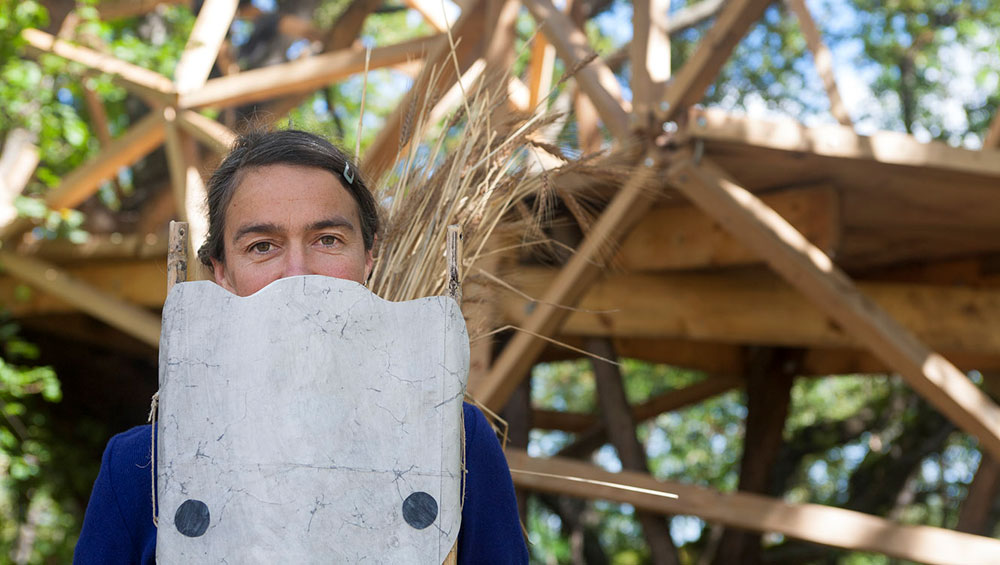
by ANNA McNAY
Amy Franceschini (b1970) founded Futurefarmers in 1995 as a design studio and a residency programme, while she was working in corporate America as a designer. Having grown up torn between two ideologies – chemical farming and a more Rudolf Steiner-based approach – her work often initiates dialogue between those with opposing views. Working on projects across the globe, Franceschini and three fellow Futurefarmers are currently involved in Seed Journey, a project based in Oslo, which is travelling to the UK for a residency at Delfina Foundation, London, and Artes Mundi 7 (at the National Museum Cardiff, 21 October 2016 – 26 February 2017), as one of the six nominated artists for the £40,000 prize.
Studio International met with Franceschini at Delfina Foundation to talk about her atypical background, Futurefarmers, and Seed Journey.
Anna McNay: Can you start by telling me a bit about your background and your artistic training, because it’s not that typical, is it?
Amy Franceschini: Being here in Europe, you’re right, it seems like I’m not so typically art trained, because people seem to say: “I went to this academy” or “I went to that academy.” I went to a state university for undergraduates and I actually wanted to study photojournalism, but I got kicked out and was told to go to the “rock and stone” department – which was the art department. When I was in journalism, I was taking pictures of endangered landscapes – farmlands that were going to become bedroom communities [dormitory towns] – and they were really boring. They were empty landscapes and not very interesting at all. And so the teacher said: “Go and take art photographs.” So I went to the art department and there were budget cuts like crazy that year so the photo labs would close at 5pm. Every other department had people working late – doing sculpture until midnight – and so I decided to go and hang out over there. So, basically, I studied photography in the art department, but I mainly did sculpture and ceramics. It wasn’t until maybe five years ago that I realised how much ceramics has influenced my work. I think it has to do with the collectivity of firing a kiln. You have to collaborate, you have to be respectful, everybody has to load the kiln together. If you make something that is going to explode, you’re going to ruin everyone else’s work. In our particular department, everyone had to rework the used clay into slip, and you had your duties – it was like being on a ship. I think that spirit of collaboration really influenced me.
Then I was still interested in photojournalism, so I went to work for a free magazine where I was in charge of transcribing interviews with successful photojournalists working for National Geographic, or Geo, or big magazines doing big political stories, but where only diluted versions were being presented, and this magazine was trying to give them a voice for their true experiences. In exchange for working there, they taught me Photoshop. I’d just started making these weird design projects and one of the photographers asked me if I wanted to make an online magazine together. This was 1993. He introduced me to his programmer and they showed me the internet. It was only text back then – no images. I designed the magazine for five years and it was acquired by the Museum of Modern Art in San Francisco. From that, we just got tonnes of press, and international companies from Japan – Nike and Hewlett Packard – wanted us to design their websites. We got woven into creating a company and I ended up working in corporate America for five years. I worked for George Lucas [the creator of Star Wars] and made a lot of money. I was totally not satisfied with that work, but I learned the tools of marketing.
Futurefarmers was founded during that time as a design studio and a residency programme. The deal was that people would come and work for us and we’d start to build a team organically, just like that. Residents would come and they’d continue to work with us and become partners. We did design work for corporations until 2000, but we would use the money either to take time off and make artworks, or to support other artists.
Then in 1999 I got a call from Stanford University asking if I wanted to go to grad school. I thought: “No, not really!” I had never wanted to go back to school, so I asked what they meant and what the programme was. They said it was an art programme, but I said no, I didn’t want to go back to school. Then everybody found out and was like: “You turned down Stanford? They’re like the most competitive school and they called you?” Then I researched it a bit and it’s the only programme in the United States where you get paid to go to school. You get paid $16,000 – maybe it’s $20,000 now – and you get a studio and research money. It’s amazing. And it’s a great university. So, the next year I applied and I got in. Many people said: “Don’t do it, it’s going to ruin you!” But I’m glad I went to that school, because there’s not much of a programme – you have to make your own. It’s more like doing paid research for two years.
So I don’t feel like I’m professionally trained as an artist. I teach young artists in art academies now and sometimes I think I’m doing them a disservice because I find the art world – the big A Art world – quite limiting and quite insular. Things all look the same during certain years. What we’re trying to do in our work, not as artists but as people, is steer away from mass movements and question things like trends and how they develop. I’m often quite embarrassed when my art students ask me which art galleries they should go to and I say to take a look at the anthropology museum, or to go for a walk in the countryside. I feel very fortunate to have been accepted and supported by the art world because I’ve found that it is the most open space to ask the questions that we’re asking and to express them in a multitude of modes and forms. Our background in design with corporations is about quick, fast communication and often we’ve been critiqued as falling into that category of design and architecture – but I don’t really mind. I love living in all those worlds.
AMc: When you say “we”, you’re talking about Futurefarmers?
AF: Yes. Futurefarmers is a collective of five core members but, through our residency programme, we have a network of 33 artists and designers. We rise up for projects based on the individual interests of members, as well as depending on time and availability. So, in Oslo, we’re a group of four, working on this flatbread project [a public artwork called the Flatbread Society], but then, in Moscow, I’m working on a project where there’s just two of us. We all also have our own individual practices. As the founder of Futurefarmers, it’s really a dream and vision of mine, and I think I’m the only one who really always wraps my individual projects into Futurefarmers. It’s rare that I do something as Amy Franceschini. When we do all work together, we call it Futurefarmers, but one of our collaborators is an architect, one is a professor, one is a media producer for museums, and I teach. That’s how we make our own livelihoods. As a collective, it’s very hard, even with the support of institutions and museums. With five members, if we have a $1,000 stipend, it doesn’t go very far. In some cases, we’ve got lucky and asked the museums to reconsider how they’re spending the money for our project and, for example, asked that rather than having an event catered, can we have that money redistributed to us. Then we bring in farmers that we know to cater the event. It’s just a matter of rethinking things a little.
AMc: Where does your interest in environmental issues and gardening and food and sustainability and so on come from?
AF: I grew up in a very small town in California in the middle of what is called “the breadbasket of America”. It’s just like this flat area of industrial agriculture. My father was a big farmer and he owned a pesticide company. He was very conservative. I was very sick as a child. I had breathing problems. And every time the airplanes would come and spray chemicals, I’d have to go to the hospital and they’d have to give me oxygen. My mother was, at that point, starting to study Rudolf Steiner and organic farming and was starting to get some clues that this kind of farming was not healthy. My parents divorced and my mum and I moved to the coast and she became an activist against chemical fertilisers. The thing I saw growing up between these two ideologies was that they both honestly thought that they were growing healthy food for people. My dad thought he was providing food for America and the world – he was a big-time commodity farmer. He was convinced that chemical fertilisers were the only way to feed the world and he used to stir the chemicals with his hands. He’s 86 and still healthy! But I think seeing the health impact of industrial agriculture on the communities around where I grew up – the area I lived in had the highest rate of breast cancer in the country, as well as asthma, diabetes, heart disease and Parkinson’s – because basically what they’re doing is introducing organophosphates (like those used in nerve gas) to kill the bugs and it’s attacking the nervous system – so hyperactivity and ADD, they think all of these illnesses are related to eating food that has these nerve agents in it. Through farming, I saw the connection of politics and power. I saw how the politics of marketing and trade and commodities all tied in. But I also started to see about the environment. I saw how the chemical water that went into the creeks started making the frogs become deformed and Silent Spring [a book by Rachel Carson, published in 1962, that warned of the dangers of pesticides to the environment] was written, which was a big eye-opener to a lot of people. It’s kind of simple: I want to be alive and I want to breathe.
I find, in the work we do as artists, that food and farming are a way of bringing people together. People like my father, who is very conservative, and very radical people can come together to talk about food.
AMc: That brings us nicely to talking about your residency here at Delfina Foundation as part of its Politics of Food season.
AF: Yes. At Delfina, I’m focusing on the Seed Journey. It is a seafaring journey that is part of the Flatbread Society project that has been running in Oslo for five years now, with an urban farm, that has as its centrepiece a grain field of ancient grains that fell out of production in the late 1800s and were found by various farmers and historians in strange locations and brought back into production. We also have a permanent bakehouse, which is quite experimental architecture, fashioned after a boat, where one side is a bakehouse and the other side is a greenhouse. Inside the bakehouse are three ovens. The idea is to make visual the line of consumption from sowing seeds to consuming food and then to programme that space. The Seed Journey came out of wanting to take these seeds on a reverse migration back to where they were domesticated. It was a seed of an idea and then so many people got excited about it and said: “Oh, you should take a rescue boat” or “Oh, you should go to Palestine and work with Vivien Sansour, who’s starting the first botanical garden” or “Oh, you should …” So we compiled a crew and it’s grown so that now there’s a rotating crew of artists and researchers who come on and off the boat. The cargo we’re carrying comprises nine varieties of these old grains. We’re going all the way to Istanbul, stopping at various locations along the way, where other people are seed saving, and they’ll give us their seeds and we’ll give them our seeds. The idea at Istanbul is that we’ve been asked to make a grain field, with all of these different grains, in a bostan, which is an inner city garden, in a whole ring of inner city gardens around the city – the idea being that the city might produce some of its own food within the city limits. These are really vibrant spaces, but they’re endangered due to gentrification. The area that we’re working with in Oslo also has some similar issues of gentrification going on, so we thought it would be interesting to have these two locations as the origin and destination.
AMc: Will you be coming via the UK at all en route?
AF: Yes. The boat will be in London on 28 September at Hermitage Moorings in east London. We are coming as part of the Artes Mundi project and Delfina was interested in supporting this journey. While I’m here in London now on this residency, I’m mainly producing work for Artes Mundi. I’m making a sail for the exhibition and we hosted an event on 13 August, a conversation between Mike Ambrose, who is a senior scientist, crop genetics for the John Innes Centre and whose job is to maintain pure races of old grains, and Andrew Forbes, who is a guerrilla farmer, doing the same thing about pure race, but bringing back these ancient grains into production in allotments and community gardens around south London and baking bread with these grains. He runs Brockwell Bake and uses the bakery as a soapbox for talking about these grains. He has the largest database of the genetic stories of grains. The event was at a bakery and we made bread with the grains, as well. Delfina is basically supporting some production and helping me get more literate in how to talk about what we are doing.
AMc: Will the boat also be going to Cardiff for the Artes Mundi exhibition?
AF: No, the boat’s keel is too deep to get through the canal and we won’t have time to go all the way around, so we’re taking a canal boat from London to Cardiff. Our boat, the Christiania, will be here in London during that time. Artes Mundi helped us connect to a canal boat to get us to Bristol, and then we take another sail boat, the Olga, across the Bristol channel to Cardiff.
AMc: What will visitors be able to see in the Artes Mundi exhibition in the National Museum Cardiff?
AF: There will be a representation of the boat, created with tables. There will be seeds in the mast in a sculpture called Seed Mast. Basically, it’s playing with the idea that the seeds are still operating outside the certified seed world, so, in a way, they’re illegal. I’m thinking about the seeds as contraband in this mast as we sail through all the different countries. The sail will also be used as backdrop for a theatre. There will be wooden boxes, used for provisions, but they will make seats. An actor will come in and read stories about birds on seafaring adventures to a canary. Canary owners have been recruited to bring in their birds for two-hour sessions. We’re only doing seven sessions, so we’re recording what the actor is reading on to a 78 record. There will be a gramophone playing the texts when the actor isn’t there. There will also be a miniature sail boat within our larger boat, and this will contain all our seeds, so the idea is that, if our boat goes down, the mast goes up, and the seeds can be rescued. We can go down, but the seeds get to live! Also, the seed vessels will be on display. There are 32 of them. Inside each wooden vessel is a blown-glass hourglass that holds the seeds. And then seed cards will be shown, which have on them the story of the seed. Each seed has a story and profile about its history and the last time it was farmed and speculation about where it came from. On the wall, there will be the morse code for a quote from a farmer we have been working with: “We don’t need a museum to preserve varieties. What we want is to plant them in the soil.” We are going to paint this on the wall with the charcoal that we’ve been using in our bakehouse to send smoke signals of this morse code. In Oslo, every time we have a bake programme, we start the session by opening and closing the chimney of the oven to have these messages be carried out by the trade winds to locations that we all meditate on. We inaugurated the bakehouse in London on 16 September and we will bring the charcoal from this event to Artes Mundi.
AMc: When you make the smoke signals, are they recorded in any way?
AF: Yes, we have a documentary video, which was made in Istanbul, and I’m negotiating at the moment to have this shown in the exhibition to help contextualise things.
AMc: How did you get involved in a project like this? Was it something you dreamed up?
AF: The Flatbread Scoiety project in Oslo came out of a project that I did in San Francisco, called Victory Gardens. Claire Doherty had seen that project and she was commissioned to ask three artists to do a public artwork in Oslo, so she recruited me. At first, I wasn’t sure it was the right place, but it’s been the most resourceful project. We’ve had a year to do research and make up a proposal and we proposed to occupy this underutilised common area to make an urban farm, bakehouse and grain field. And then, out of that, came Seed Journey. It was kind of a fantasy and then people projected their imagination on to it and, whoosh, it’s happened.
• For more information on Futurefarmers, click here.
• The Politics of Food is a four-year programme of artistic research and production at Delfina Foundation.
• The Artes Mundi exhibition will run from 21 October 2016 – 26 February 2017 at the National Museum Cardiff and at Chapter, Cardiff. The prize announcement will be on 26 January 2017.
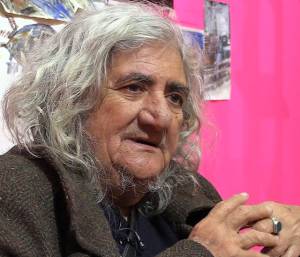 Anna Boghiguian, interview, Artes Mundi 8
Anna Boghiguian, interview, Artes Mundi 8
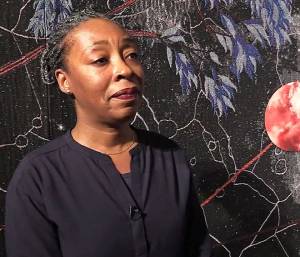 Otobong Nkanga, interview, Artes Mundi 8
Otobong Nkanga, interview, Artes Mundi 8
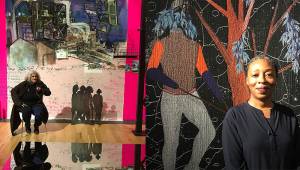 Artes Mundi 8 Prize and Exhibition
Artes Mundi 8 Prize and Exhibition
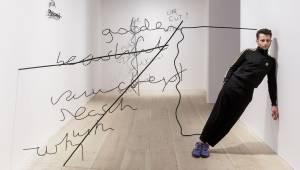 Alex Mirutziu: ‘I’m interested in error, misunderstanding, correction’
Alex Mirutziu: ‘I’m interested in error, misunderstanding, correction’
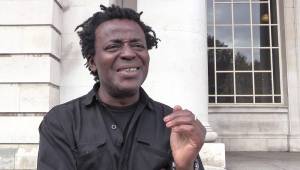 John Akomfrah – interview: ‘The question of discourse is absolutely central’
John Akomfrah – interview: ‘The question of discourse is absolutely central’